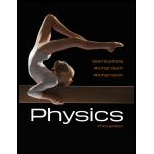
(a)
The entropy change in the universe.
(a)
Answer to Problem 73P
The change in entropy of universe is
Explanation of Solution
The mass of the first block of iron is
Write the formula for the change in entropy of a system.
Here,
The change in entropy of the universe is the sum of change of entropy of the two blocks.
Here,
Re-write the above equation by substituting the individual expressions.
Here,
Re-write the above equation by substituting the individual expressions.
Here,
Conclusion:
Substitute
The change in entropy of universe is
(b)
The entropy change in the universe.
(b)
Answer to Problem 73P
The change in entropy of universe is
Explanation of Solution
The mass of the first block of iron is
Write the formula for the change in entropy of a system.
Here,
The change in entropy of the universe is the sum of change of entropy of the two blocks.
Here,
Re-write the above equation by substituting the individual expressions.
Here,
Re-write the above equation by substituting the individual expressions.
Here,
Conclusion:
Substitute
The change in entropy of universe is
Want to see more full solutions like this?
Chapter 15 Solutions
Student Solutions Manual for Physics
 College PhysicsPhysicsISBN:9781305952300Author:Raymond A. Serway, Chris VuillePublisher:Cengage Learning
College PhysicsPhysicsISBN:9781305952300Author:Raymond A. Serway, Chris VuillePublisher:Cengage Learning University Physics (14th Edition)PhysicsISBN:9780133969290Author:Hugh D. Young, Roger A. FreedmanPublisher:PEARSON
University Physics (14th Edition)PhysicsISBN:9780133969290Author:Hugh D. Young, Roger A. FreedmanPublisher:PEARSON Introduction To Quantum MechanicsPhysicsISBN:9781107189638Author:Griffiths, David J., Schroeter, Darrell F.Publisher:Cambridge University Press
Introduction To Quantum MechanicsPhysicsISBN:9781107189638Author:Griffiths, David J., Schroeter, Darrell F.Publisher:Cambridge University Press Physics for Scientists and EngineersPhysicsISBN:9781337553278Author:Raymond A. Serway, John W. JewettPublisher:Cengage Learning
Physics for Scientists and EngineersPhysicsISBN:9781337553278Author:Raymond A. Serway, John W. JewettPublisher:Cengage Learning Lecture- Tutorials for Introductory AstronomyPhysicsISBN:9780321820464Author:Edward E. Prather, Tim P. Slater, Jeff P. Adams, Gina BrissendenPublisher:Addison-Wesley
Lecture- Tutorials for Introductory AstronomyPhysicsISBN:9780321820464Author:Edward E. Prather, Tim P. Slater, Jeff P. Adams, Gina BrissendenPublisher:Addison-Wesley College Physics: A Strategic Approach (4th Editio...PhysicsISBN:9780134609034Author:Randall D. Knight (Professor Emeritus), Brian Jones, Stuart FieldPublisher:PEARSON
College Physics: A Strategic Approach (4th Editio...PhysicsISBN:9780134609034Author:Randall D. Knight (Professor Emeritus), Brian Jones, Stuart FieldPublisher:PEARSON





